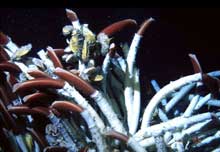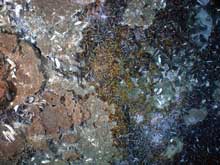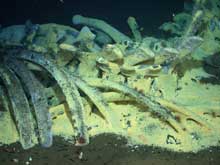
The giant tubeworm, Riftia pachyptila, from the hydrothermal vents at the East Pacific Rise at 2,500 m depth. Each individual in the photo exceeds one meter in length. Click image for larger view and image credit.
A chemoautotrophic whale-fall community, including bacteria mats, vesicomyid clams in the sediments, galatheid crabs, polynoids, and a variety of other invertebrates. The 35-ton gray whale was originally implanted on the sea floor at 1,674 m depth in the Santa Cruz Basin in 1998. This image was captured six years later by Craig Smith from the University of Hawaii. Click image for larger view and image credit.
One Piece at a Time
May 16, 2006
Jeremy Potter
NOAA Ocean Exploration
27 38.67 N
088 21.90 W
All life is based on energy derived from the sun. That accepted paradigm was thrown out the window in February 1977 when the deep submergence vehicle (DSV) Alvin dove for the first time on hydrothermal vents at the Galapagos Rift in the Pacific.
What scientists stumbled upon fundamentally changed our understanding of life on Earth. Deep below the surface of the ocean, in areas devoid of light but subject to intense pressure and temperatures, they found an oasis of animal life that rivaled science fiction. That day marked the discovery of "alien" life on Earth: entire ecosystems based on energy from something other than the sun.
Since that discovery, other types of deep-sea chemosynthetic communities have been found. In 1984, scientists discovered cold seeps both off the coast of California and here in the Gulf of Mexico. (We now know about other examples of these communities.) Large biomass falls in the form of whale carcasses or sunken wood decompose and provide energy for a variety of microbial and invertebrate communities. In fact, chemosynthetic communities are not limited to the deep-sea. They can even found in mundane places like sewage outfalls and even the stinky sediments of intertidal mudflats.

Bacterial mats, mussels, and tubeworms are common at cold seeps. This image from Atwater Valley Site 340 in the Gulf of Mexico was captured with a downward-looking camera mounted on the deep submergence vehicle Alvin. Click image for larger view and image credit.
Despite almost 30 years of scientific work on these deep-sea communities, our understanding of the biogeography of chemosynthetic systems is limited to detailed studies of a relatively small number of sites around the globe. Studying these sites requires expensive research vessels and equipment and a great deal of coordination. There are still many fundamental questions to be answered.
Though paradigm-changing discoveries don’t happen with every Alvin dive, each dive we make during this expedition on cold seeps fills in another small piece to the immense puzzle surrounding chemosynthetic communities.
Sign up for the Ocean Explorer E-mail Update List.





























